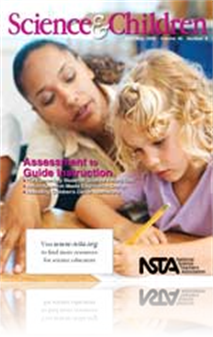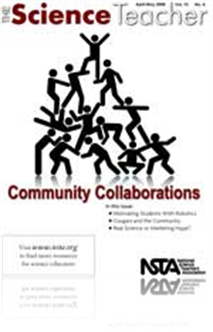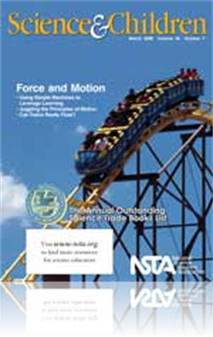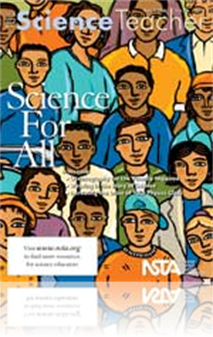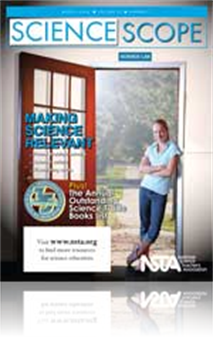All Resources
Journal Article
Science 101: How do animals communicate underwater?
Well, they often use hand signals, such as the “OK” sign, and sometimes they write on message boards. So much for how SCUBA divers (classified as animals) communicate! Other than the authors’ knowledge of sound waves and how they move air and w...
Journal Article
The analysis and activities described in this article provide high school chemistry and science teachers with hands-on lab experiments designed to make students more aware of corrosion and the processes used to prevent or control it (D’Agostino 200...
Journal Article
The “Learning Lab: The Cell” exhibit was developed by the Massachusetts Institute of Technology (MIT) Museum and the MIT Center for Environmental Health Sciences (CEHS). Specially designed for middle and high school students, the Learning Lab pro...
Journal Article
Scope on Safety: Avoid surprise packages
The Hazardous Materials Regulations (HMR), parts 171—180 explain what is required of a shipper to transport hazardous materials safely. The regulations cover classification, packaging, incident reporting, and handling of hazardous materials. Hazard...
Journal Article
Science Sampler: Teaming up for better teaching
Lesson study is a form of professional development that has spread across the United States from its origin in Japan (Stigler and Hiebert 1999; Lewis, Perry, and Hurd 2004). In lesson study, teachers form a collaborative team that changes both the wa...
Journal Article
Editor’s Roundtable: Professional development—A thousand kilometers wide and a micron deep!
A long-term, coherent program of high-quality professional development (PD) is the best way to foster improvement in classroom practices and student learning. Administrators and district office personnel must make high-quality professional developmen...
Journal Article
In Praise of Performance-Based Assessments
Performance-based assessments are tasks conducted by students that enable them to demonstrate what they know about a given topic. The difference between this type of “test” versus the traditional method is that students are given the opportunity ...
Journal Article
Editor’s Corner: A Community of Learners
In addition to supporting the exchange of ideas within the science teaching community, The Science Teacher (TST) also supports the notion of community in its widest sense, by including articles that connect students and teachers with the community be...
Journal Article
Teaching Through Trade Books: Taking Note of Natural Resources
The idea of “going green” or being aware of and reducing our impact on natural resources is receiving a lot of attention these days. Schools are starting to employ “green” practices and are soliciting help from the students to be aware of and...
Journal Article
This hands-on, minds-on zoo project provides a fun and safe opportunity for students to experience the world of animals and nature right in their own classroom. Students have the chance to work individually or in small groups to explore, observe, and...
Journal Article
Outstanding Science Trade Books for Students K—12 (Books Published in 2007: Science and Children)
Each of these outstanding selections defies the traditional image of a child “curling up with a good book.” Yes, they can be a source of great personal reading, encouraging students of all ages to stretch their skills and their imagination as the...
Journal Article
Editorial: Research and Teaching Column
The JCST Research and Teaching column will feature sound research on curriculum, pedagogy, and student learning at the college level. Topics of interest include all fields of science: chemistry, biology, geology, astronomy, physics, geography, mathe...
Journal Article
Oceanography for the Visually Impaired
Amy Bower is a physical oceanographer and senior scientist at the Woods Hole Oceanographic Institution (WHOI) in Woods Hole, Massachusetts—she has also been legally blind for 14 years. Through her partnership with the Perkins School for the Blind i...
Journal Article
Science Shorts: “Knowing” Newton
Newton’s Laws seem simple and familiar. Despite their apparent simplicity, these laws are often misunderstood. In the following lesson, students will become better acquainted with Newton and his laws as they test what happens when a force is applie...
Journal Article
Career of the Month: An Interview With Cosmetic Chemist Amy Wyatt
Where do you turn when you have a bad hair day or need to cover up an unwanted blemish? From hair gels to concealers, cosmetic chemists use science and creativity to develop products that make us look and feel good. As the executive director of Chane...
Journal Article
Scope on the Skies: Tracking planets around the Sun
In earlier columns, the celestial coordinate system of hour circles of right ascension and degrees of declination was introduced along with the use of an equatorial star chart (see SFA Star Charts in Resources). This system shows the planets’ motio...
Journal Article
In this problem-based learning activity (PBL), students embark on a science trek to answer the question “Where is the science in my neighborhood?” The project serves as an excellent review of science curriculum in anticipation of Virginia’s yea...
Journal Article
Science Sampler: Wanted—Citizen Scientists
As middle school students and teachers become involved in citizen-scientist activities, their awareness of important environmental issues will be enhanced. Here the author shares her involvement in a partnership with the Great Smoky Mountains Institu...
Journal Article
Outstanding Science Trade Books for Students K—12 (Books Published in 2007: Science Scope)
Each of these outstanding selections defies the traditional image of a child “curling up with a good book.” Yes, they can be a source of great personal reading, encouraging students of all ages to stretch their skills and their imagination as the...
Journal Article
Helping Students With Learning Disabilities Succeed
Students with learning disabilities (LD) frequently take general education science classes because their disabilities are very mild. Sometimes, however, it is difficult for students with LD to succeed in the classes and pass the related high-stakes a...
Journal Article
A well-structured independent literature research project with a poster session was used to introduce students to peer-reviewed literature in a general chemistry course. Overall, students reported an enhanced appreciation of the course due to perform...
Journal Article
Reading Questions in Large-Lecture Courses: Limitations and Unexpected Outcomes
As an alternative to reading quizzes, a team of biochemistry instructors implemented student reading questions (Henderson and Rosenthal 2006) as a new instructional strategy within their large-enrollment biochemistry courses. Unexpected positive outc...
Journal Article
This monthly feature contains facts and challenges for the science explorer. ...
Journal Article
Problem Solving in Biology: A Methodology
A methodology is described that teaches science process by combining informal logic and a heuristic for rating factual reliability. This system facilitates student hypothesis formation, testing, and evaluation of results. After problem solving with t...
Journal Article
Helping Students Write Better Conclusions
Unlike the vocabulary used in language arts and social studies, knowledge of expository text (text written to inform) and the language of science are required for reading and writing in science (Carrier 2005). This vocabulary, along with expository t...
Journal Article
Scope on Safety: Should we pull the plug on wireless computer networks?
Wi-Fi, or wireless fidelity, is a type of wireless local area network (WLAN). Two or more computers form the network using radio frequency (RF) signals. The safety of these networks, however, has come under scrutiny in recent years. Some parents have...
Journal Article
The Technology-Enhanced Learning in Science (TELS) center, a National Science Foundation-funded Center for Learning and Teaching, offers research-tested science modules for students in grades 6—12 (Linn et al. 2006). These free, online modules enga...
Journal Article
Increasing the Drive of Your Physics Class
First-year physics students often have a difficult time grasping Newton’s laws of motion and recognizing the forces that these laws depend on. The “Paper Car” project is an experiential activity that is rich in application of force principles. ...
Journal Article
Editor’s Note: Force and Motion—Complex, Awesome, Relevant
We know that when something is relevant to a student, the student is more motivated to learn and also more likely to remember. What could be more relevant than force and motion? The universe, like an eight-year-old, is in constant motion. Force and m...
Journal Article
Society for College Science Teachers: If You Go Down to the Woods Today…
In this month’s column, the author reflects on his childhood experiences of “playing in the woods” and his insatiable love of the outdoors as compared to today’s youth, who spend the majority of their free time inside their technology-filled ...
Journal Article
Case Study: Ah-choo! Increased Risk of Pollen Allergies in the Northern Hemisphere
In this problem-based learning activity designed for nonscience majors, students assume the roles of scientists working for a public relations firm. Teams of students design communication products illustrating links between climate change and pollen ...
Journal Article
Editor’s Corner: Science for All (March 2008)
This issue of The Science Teacher (TST) represents our 13th consecutive annual issue devoted to the theme “Science for All.” The theme serves as an umbrella for ideas and strategies to mitigate academic achievement gaps associated with ethnicity...
Journal Article
Tried and True: Volcano résumés
Tired of building a paper mâché volcano to teach about plate tectonics? Do you want to connect science and writing? Then the volcano résumé project is perfect for you. This one-week, problem-based learning (PBL) project requires students to resea...
Journal Article
Have you ever heard of a Maglev train? Who would be crazy enough to think that exploring how a high-tech train little known in the United States works with a group of fourth-grade students would yield understandings about the properties of magnetism,...
Journal Article
Using Simple Machines to Leverage Learning
What would your students say if you told them they could lift you off the ground using a block and a board? Using a simple machine, they’ll find out they can, and they’ll learn about work, energy, and motion in the process! In addition, this inte...
Journal Article
A Novel Lecture Series and Associated Outreach Program in the Environmental and Natural Sciences
To address the low priority given to university-level outreach, the authors created an outreach program that makes it easy for scientists to connect with the public, while at the same time providing effective transfer of scientific research results t...
Journal Article
The indigo carmine demonstration (Ferguson et al. 1973), also referred to as a traffic-light demonstration (Flinn Scientific 2007a), is an example of a set of oxidation-reduction reactions that occurs within one solution. This type of demonstration c...



